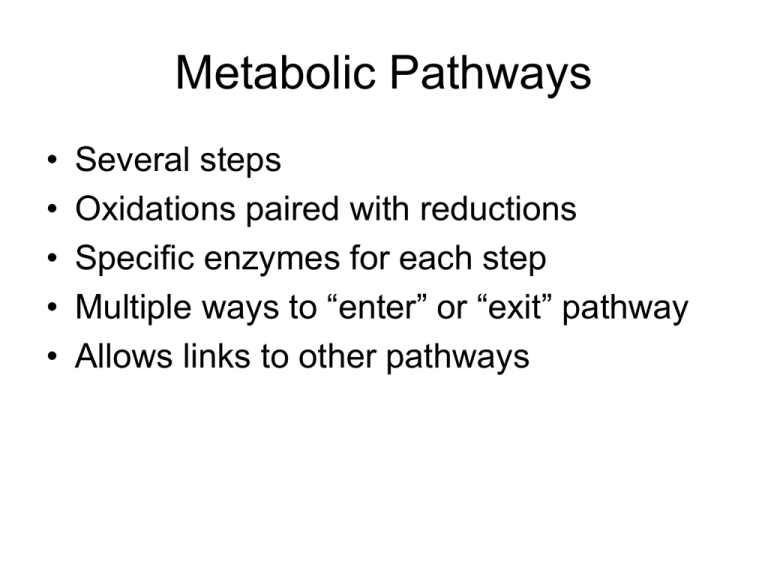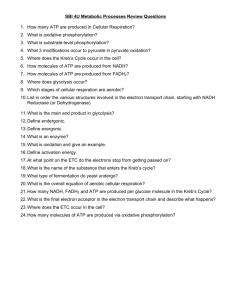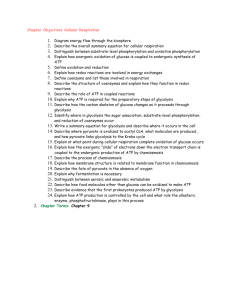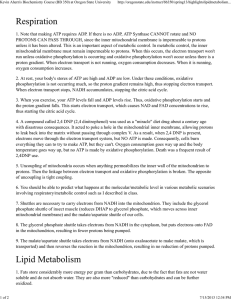Figure 9.1 Energy flow and chemical recycling in ecosystems
advertisement

Metabolic Pathways • • • • • Several steps Oxidations paired with reductions Specific enzymes for each step Multiple ways to “enter” or “exit” pathway Allows links to other pathways Thermodynamics • First law? – All about energy TRANFER, need to be able to trace where all the energy ends up – Usually a partial transfer – Combustion on a SLOW scale • Energy coupling Figure 6.9 Energy coupling by phosphate transfer Basic Energy molecules • ATP/GTP • Electron Carriers – NADH, FADH2, NADPH – Ways of moving energy around; Figure 9.7 Substrate-level phosphorylation Oxidative phosphorylation • Involves the oxidation of electron carriers, chemiosmosis and oxygen. • We’ll elaborate more on this later. Figure 9.2 A review of how ATP drives cellular work Oxidation and Reduction • Always Paired together • What happens in a reduction reaction? • What happens in an oxidation? • What happens to the free energy of a molecule when it is reduced? VERY IMPORTANT!!!! Figure 9.3 Methane combustion as an energy-yielding redox reaction We can summarize the two energy-coupling coenzymes as follows: 1. ADP traps chemical energy to make ATP. 2. NAD+ traps the energy released in redox reactions to make NADH Catabolism vs. Anabolism - What’s going on with the energy? - Which would be paired with ATP ADP - Which might be paired with NAD+ NADH BUT energy in NADH can not be used directly • Oxidative Phosphorylation couples the oxidation of NADH (energy out) with the Phosphorylation of ADP (energy in) • Requires Chemiosmosis – using potential energy in H+ gradient to drive ADP ATP • This process is essential to both photosynthesis AND aerobic cell respiration Figure 9.1 Energy flow and chemical recycling in ecosystems Aerobic Cell Respiration • Complete oxidation of glucose – Glucose CO2 endo or exo? – What are the reactions that break glucose down likely to be paired with? • Reduction or oxidation of electron carriers? • Phosphorylation or hydrolysis of ATP? Figure 9.6 An overview of cellular respiration (Layer 3) Figure 9.8 The energy input and output of glycolysis Figure 9.9 A closer look at glycolysis: energy investment phase (Layer 2) Figure 9.9 A closer look at glycolysis: energy payoff phase (Layer 4) Know your enzymes • Kinases – Linked with? • Isomerases • Dehydrogenases – Linked with? Glycolysis Summary • Started with? • Ended with? • Where is the bulk of the energy? • Location? • Aerobic? Figure 9.10 Oxidation of Pyruvate ** remember we have TWO pyruvates per glucose, so everything from here on out is doubled!!** Keep the tally going! • What do we have now? Krebs Cycle (a.k.a. citric acid cycle) - complete oxidation of Acetyl CoA’s carbons into CO2 Figure 9.12 So after Krebs what are we left with? Where is the energy? Can we use it all? Electron carriers need to be oxidized • NADH + H+ + ½ O2 NAD+ + H2O • Requires Electron Transport Chain (respiratory chain) – Electrons are passed from membrane bound protein to membrane bound protein in a series of oxidations – EXERGONIC! • Energy released actively transports H+ across membrane establishing a gradient Figure 9.14 ATP synthase, a molecular mill Final Tally • What do we have now? • Why is oxygen needed? • What happens in absence of O2? • Solution? Figure 9.18 Pyruvate as a key juncture in catabolism Figure 9.20 The control of cellular respiration Figure 9.19 The catabolism of various food molecules Figure 10.2 Focusing in on the location of photosynthesis in a plant Figure 10.4 An overview of photosynthesis: cooperation of the light reactions and the Calvin cycle (Layer 3) Figure 10.5 The electromagnetic spectrum Figure 10.6 Why leaves are green: interaction of light with chloroplasts Figure 10.7 Determining an absorption spectrum Photons absorbed by molecules raise the molecule to an excited state. Figure 10.8 Evidence that chloroplast pigments participate in photosynthesis: absorption and action spectra for photosynthesis in an alga Figure 10.9 Location and structure of chlorophyll molecules in plants Figure 10.10 Excitation of isolated chlorophyll by light Figure 10.11 How a photosystem harvests light Figure 10.12 How noncyclic electron flow during the light reactions generates ATP and NADPH (Layer 5) Figure 10.13 A mechanical analogy for the light reactions Figure 10.14 Cyclic electron flow Figure 10.15 Comparison of chemiosmosis in mitochondria and chloroplasts Figure 10.16 The light reactions and chemiosmosis: the organization of the thylakoid membrane Figure 10.17 The Calvin cycle (Layer 3) Figure 10.19 C4 and CAM photosynthesis compared Figure 10.18 C4 leaf anatomy and the C4 pathway Figure 10.20 A review of photosynthesis




